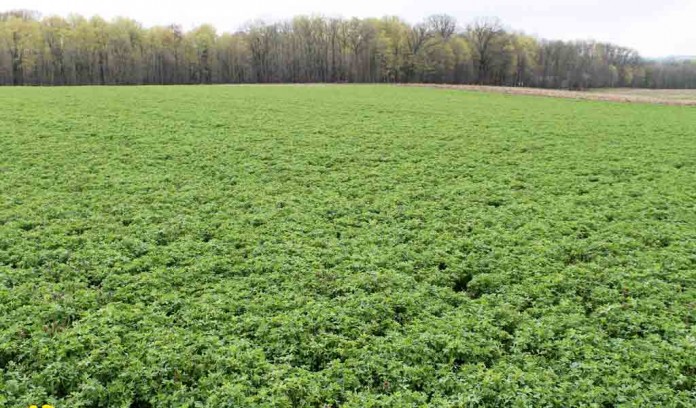With the wet weather last fall and this winter, we will likely lose some of our alfalfa stands.
The first task is to obtain a soil sample or samples. If the field is less than 15 acres, then a single soil sample will suffice. If the field is larger than 15 acres, take multiple samples based upon management zones or based upon a grid pattern.
It is best to start sampling by a grid method before going to a zone method, so you can more accurately variable rate the fertilizer and/or lime. Management zones can be based upon soil type, topography, soil organic matter, or a combination of these.
Obtain soil samples
If a field has been in no-till and the field will remain untilled, obtain soil samples at two depths, one at a 4-inch depth for pH and another at an 8-inch depth for fertilizer recommendations. For good establishment of alfalfa, soil pH needs to be at 6.8 for mineral soils having a subsoil pH of less than 6.0 and 6.5 for mineral soils having subsoil pH greater than 6.0.
Bray P1 soil test phosphorus (P) levels should be between 25 and 50 parts per million (ppm). The Mehlich III soil test P levels should be between 40 and 79 ppm.
The recommended rate of potash is based upon the soil test level in ppm, the cation exchange capacity, and yield goal. If lime is required and the Bray P1 soil test value for phosphorus is below 25 ppm, delay planting until the fall or next spring as stand establishment will likely be poor due to the poor fertility.
Fertilizer and lime should be incorporated to maximize nutrient efficiency. If surface applying lime and fertilizer it is even more important to wait a year before establishing alfalfa. Select varieties having the best disease resistance (the best way to fight diseases), good forage quality, best fit to soil types, and high yields.
Treat your seed
Have seed inoculated with nitrogen-fixing bacteria to improve nitrogen uptake and treated with fungicides to manage seedling diseases, especially when planting in the spring.
Prepare a proper seedbed. A smooth firm seedbed allows for good soil to seed contact leading to improved establishment.
Control all weeds prior to establishment. Control perennial weeds the year before establishment. For no-tillage seedings, control grass sod with glyphosate at least one month in advance of seeding and manage previous crop residue for good soil to seed contact.
Seed alfalfa as early in the spring as possible. For southern Ohio, target March 15 and for northern Ohio, target April 1. For fall seedings, plant as close to Aug. 1 as possible. Seed alfalfa to a depth of 1/4 to 1/2 inch in clay and loam soils, and 1/2 to 3/4 inch in sandy soils.
The seeding rate for alfalfa is 15 pounds per acre or 80 seeds per foot of row. If the seedbed is in excellent condition and you are using a brillion packer seeder or something similar to it, the seeding rate can be reduced by 25 to 30 percent.
It is critical to properly manage leafhoppers in seedling alfalfa too keep it healthy. Successful establishment ensures the healthiest, longest lasting, and highest yielding alfalfa.













